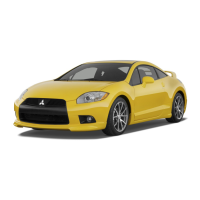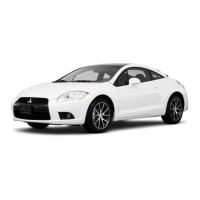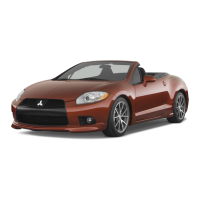1-32
ENGINE <NON-TURBO>
-
Control System
In addition to illuminating the MIL lamp, a diagnostic
trouble code (DTC) is stored in the Powertrain Con-
trol Module (PCM) and can be retrieved by a service
technician using a diagnostic scan tool.
To meet OBD-II requirements the following systems
must be monitored:
0
Catalyst
l Fuel System
l Misfire
l Oxygen Sensor and Oxygen Sensor Heater
l Secondary Air
l
Evaporative System (Purge)
l
Exhaust Gas Recirculation
l
Any other input or output component that can
affect emissions
The operating conditions of the components can
be monitored using MUT-II scan tool, as well as
general purpose scan tools. The OBD II system
monitors are different. They are checks made by
DIAGNOSTIC SYSTEM OPERATION
Trip Indicator
“Trip” is a difficult concept to define because the
requirements for a trip vary depending on the test
being run. These conditions can include seemingly
unrelated items such as driving style, length of trip,
and ambient temperature. The minimum require-
ment for a trip is that it includes one key cycle with
the vehicle having to meet certain enabling condi-
tions before a test is performed. Vehicle tests vary
in length and may be performed only once per trip
or may be performed continuously. If the pertinent
enabling conditions are not met during that key cycle,
the tests may not run at all.
NOTE
In California and other states requiring the PCM
to indicate that all monitors have passed before
issuing license plates, removing the vehicle’s battery
or using the MUT-II scan tool to erase
DTC’s
before
testing erases any record of passing a monitor. If
the monitor does not complete a trip on subsequent
key cycles, the vehicle will fail a licensing test.
What constitutes a trip for a particular OBD test
is important because in many instances, the vehicle
must fail a test on more than once before the MIL
is illuminated and a DTC is recorded. Tests that
illuminate the MIL when a single failure is recorded
are known as
“one
trip” monitors. “Two trip” monitors
the
PCM’s
software to determine not only if these
specific systems are operating, but if they are operat-
ing within pre-established limits. While OBD I tests
measure a component’s electrical operation, OBD
L)
II monitors check a system’s performance.
The California Air Resources Board (CARB) moni-
tors emission system repairs from several California
dealers. If a specific component or system fails on
more than 4% of the vehicles sampled, the manufac-
turer is required to research and evaluate the rea-
sons. If the failure is not attributable to owner negli-
gence or misuse, a component failure rate of 4%
could lead to vehicle recalls. The federal government
is considering a similar program. The manufacturer
is relying on its technicians throughout the country
to appropriately diagnose emissions concerns and
replace only those parts that have failed. The sloppy
practice of “hanging” parts on a car under emissions
warranty could lead to an unnecessary (and expen-
sive) fleet-wide recall.
N71AK33AA
allow the system to double check itself and help
prevent unnecessary MIL illumination.
If the conditions to run the test are not met on consec-
utive key cycles, the information from the first test
’
is not lost. The diagnostic system waits until the
L)
next time the appropriate test conditions occur and
continues the count.
If this is a “two trip fault” and the test failed the
first time, a malfunction the second consecutive
time the test is run (even if there were ten key
cycles between these tests) will illuminate the MIL.
If the malfunction does not occur the second time
the test is run, the MIL lamp does not illuminate
and no DTC is recorded.
The diagnostic system can turn the MIL off if it re-
cords three consecutive trips where the system
passes the test. However, with the misfire and fuel
monitors, the system must past the test under the
same circumstances (within 375 rpm) under which
it failed the test.
In summary, it is the diagnostic system’s job to deter-
mine if the conditions are appropriate for a test
to be run, know the definition of a trip for each
test, and record the results of each test when it
is run.

